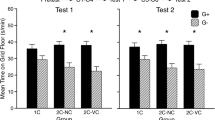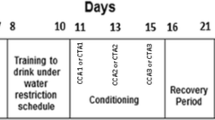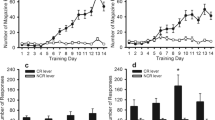Abstract
Ethanol-induced locomotor stimulation has been proposed to be positively correlated with the rewarding effects of ethanol (Wise and Bozarth 1987). The present experiments provided a test of this hypothesis using a genetic model. Three behavioral indices of the motivational effects of ethanol (drinking, taste conditioning, place conditioning) were examined in mice from two independent FAST lines, selectively bred for sensitivity to ethanol-induced locomotor stimulation, and mice from two independent SLOW lines, selectively bred for insensitivity to ethanol-induced locomotor stimulation. In a single-bottle procedure, mice were allowed access to drinking tubes containing ethanol in a concentration (1–12% v/v) that increased over 24 consecutive days. FAST mice consumed greater amounts of ethanol solution. In a two-bottle procedure, mice were allowed access to tubes containing water or various concentrations of ethanol (2–8% v/v) over 6 days. FAST mice generally showed greater preference for ethanol solutions than SLOW mice. In a conditioned taste aversion procedure, mice received access to saccharin solution followed by injection of 2.5 g/kg ethanol (IP). SLOW mice developed aversion to the saccharin flavor more readily than FAST mice. In a series of place conditioning experiments, tactile stimuli were paired with various doses of ethanol (0.8–2.0 g/kg). During conditioning, FAST mice showed locomotor stimulation after 1.0, 1.2 and 2.0 g/kg ethanol while SLOW mice did not. During testing, mice conditioned with 1.2 g/kg and 2.0 g/kg ethanol showed conditioned place preference, but there were no line differences in magnitude of preference. These results indicate that genetic selection for sensitivity to ethanol-stimulated activity has resulted in genetic differences in ethanol drinking and ethanol-induced conditioned taste aversion but not ethanol-induced conditioned place preference. Overall, these data provide mixed support for the psychomotor stimulant theory of addiction.
Similar content being viewed by others
References
Belknap JK, Belknap ND, Berg JH, Coleman R (1977) Preabsorptive vs. postabsorptive control of ethanol intake in C57BL/6J and DBA/2J mice. Behav Genet 7:413–425
Carr GD, Fibiger HC, Phillips AG (1989) Conditioned place preference as a measure of drug reward. In: Liebman JM, Cooper SJ (eds) Neuropharmacological basis of reward. Oxford University Press, New York, pp 264–319
Clark PBS, Kumar R (1983) The effects of nicotine on locomotor activity in non-tolerant and tolerant rats. Br J Pharmacol 78:329–337
Crabbe JC (1986) Genetic differences in locomotor activation in mice. Pharmacol Biochem Behav 25:289–292
Crabbe JC, Johnson NA, Gray DK, Kosobud A, Young ER (1982) Biphasic effects of ethanol on open-field activity: Sensitivity and tolerance in C57BL/6N and DBA/2N mice. J Comp Physiol Psychol 96:440–451
Crabbe JC, Young ER, Deutsch CM, Tam BR, Kosobud A (1987) Mice genetically selected for differences in open-field activity after ethanol. Pharmacol Biochem Behav 27:577–581
Crabbe JC, Phillips TJ, Kosobud A, Belknap JK (1990) Estimation of genetic correlation: interpretation of experiments using selectively bred and inbred animals. Alcohol Clin Exp Res 14:141–151
Cunningham CL (1993) Pavlovian drug conditioning. In: Van Haaren F (ed) Methods in behavioral pharmacology. Elsevier, New York, pp 349–381
Cunningham CL, Noble D (1992) Conditioned activation induced by ethanol: role in sensitization and conditioned place preference. Pharmacol Biochem Behav 43:307–313
Cunningham CL, Prather LK (1992) Ethanol-induced conditioned place preference in mice: Role of conditioning trial duration. J Exp Psychol [Anim Learn Behav] 20:187–194
Cunningham CL, Hallett CL, Niehus DR, Hunter JS, Nouth L, Risinger FO (1991) Assessment of ethanol's hedonic effects in mice selectively bred for sensitivity to ethanol-induced hypothermia. Psychopharmacology 105:84–92
Cunningham C L, Neihus DR, Malott DH, Prather LK (1992) Genetic differences in the rewarding and activating effects of morphine and ethanol. Psychopharmacology 107:385–393
Cunningham CL, Neihus JS, Noble D (1993) Species difference in sensitivity to ethanol's hedonic effects. Alcohol 10:97–102
Dudek BC, Phillips TJ, Hahn ME (1991) Genetic analyses of the biphasic nature of the alcohol dose-response curve. Alcohol Clin Exp Res 15:262–269
Erickson CK, Kochhar A (1985) An animal model for low dose ethanol-induced locomotor stimulation: behavioral characteristics. Alcohol Clin Exp Res 9:310–314
Frye GD, Breese GR (1981) An evaluation of the locomotor stimulating action of ethanol in rats and mice. Psychopharmacology 75:372–379
George FR, Porrino LJ, Ritz MC, Goldberg SR (1991) Inbred rat strain comparisons indicate different sites of action for cocaine and amphetamine locomotor stimulant effects. Psychopharmacology 104:457–462
Hilakivi L, Eriksson CJP, Sarviharju M, Sinclair JD (1984) Revitalization of the AA and ANA rat lines: effects on some line characteristics. Alcohol 1:71–75
Hunt T, Amit Z (1987) Conditioned taste aversion induced by self-administered drugs: paradox revisited. Neurosci Biobehav Rev 11:107–130
Imperato A, Di Chiara G (1986) Preferential stimulation of dopamine release in the nucleus accumbens of freely moving rats by ethanol. J Pharmacol Exp Ther 239:219–228
Koob GF (1992) Neural mechanisms of drug reinforcement. Ann NY Acad Sci 654:171–191
Le Moal M, Simon H (1991) Mesocorticolimbic dopaminergic network: functional and regulatory roles. Physiol Rev 71:155–234
Liljequist S, Berggren U, Engel J (1981) The effect of catecholamine receptor antagonists on ethanol-induced locomotor stimulation. J Neural Transm 50:57–67
Linakis JG, Cunningham CL (1979) Effects of concentration of ethanol injected intraperitoneally on taste aversion, body temperature, and activity. Psychopharmacology 64:61–65
Lubow RE (1973) Latent inhibition. Psychol Bull 79:398–407
Masur J, Boerngen R (1980) The excitatory component of ethanol in mice: a chronic study. Pharmacol Biochem Behav 13:777–780
Masur J, Oliveira De Souza ML, Zwicker AP (1986) The excitatory effect of ethanol: absence in rats, no tolerance and increased sensitivity in mice. Pharmacol Biochem Behav 24:1225–1228
McClearn GE, Rodgers DA (1959) Differences in alcohol preference among inbred strains of mice. Q J Stud Alcohol 20:691–695
Meisch RA, Carroll ME (1987) Oral drug self-administration: drugs as reinforcers. In: Bozarth MA (ed) Methods of assessing the reinforcing properties of abused drugs. Springer, New York, pp 143–160
Phillips TJ, Crabbe JC (1991) Behavioral studies of genetic differences in alcohol action. In: Crabbe JC, Harris RA (eds) The genetic basis of alcohol and drug actions. Plenum, New York, pp 25–104
Phillips TJ, Feller DJ, Crabbe JC (1989) Selected mouse lines, alcohol, and behavior. Experientia 45:805–827
Phillips TJ, Burkhart-Kasch S, Terdal ES, Crabbe JC (1991a) Response to selection for ethanol-induced locomotor activation: genetic analysis and selection response characterization. Psychopharmacology 103:557–566
Phillips TJ, Burkhart-Kasch S, Crabbe JC (1991b) Locomotor activity response to chronic ethanol treatment in selectively bred FAST and SLOW mice. Alcohol Alcohol 1[suppl]: 109–113
Phillips TJ, Burkhart-Kasch S, Gwiazdon CC, Crabbe JC (1992) Acute sensitivity of FAST and SLOW mice to the effects of abused drugs on locomotor activity. J Pharmacol Exp Ther 261:525–533
Risinger FO, Cunningham CL (1992) Genetic differences in ethanol-induced hyperglycemia and conditioned taste aversion. Life Sci 50:PL113–118
Risinger FO, Dickinson SD, Cunningham CL (1992) Haloperidol reduces ethanol-induced motor activity stimulation but not conditioned place preference. Psychopharmacology 107:453–456
Ruth JA, Ullman EA, Collins AC (1988) An analysis of cocaine effects on locomotor activities and heart rate in four inbred mouse strains. Pharmacol Biochem Behav 29:157–162
Samson HH, Tolliver GA, Haraguchi M, Hodge CW (1992) Alcohol self-administration: role of mesolimbic dopamine. Ann NY Acad Sci 654:242–253
Sherman JE, Jorenby DE, Baker TB (1988) Classical conditioning with alcohol: acquired preferences and aversions, tolerance, and urges/craving. In: Chaudron CD, Wilkinson DA (eds) Theories on alcoholism. Addiction Research Foundation, Toronto, pp 173–237
Swerdlow NR, Koob GF (1985) Separate neural substrates of the locomotor-activating properties of amphetamine, heroin, caffeine, and corticotropin releasing factor (CRF) in the rat. Pharmacol Biochem Behav 23:303–307
Vezina P, Stewart J (1987) Morphine conditioned place preference and locomotion: the effect of confinement during training. Psychopharmacology 93:257–260
Waller MB, Murphy JM, McBride WJ, Lumeng L, Li T-K (1986) Effect of low dose ethanol on spontaneous motor activity in alcohol-preferring and non-preferring lines of rats. Pharmacol Biochem Behav 24:617–623
Weeks JR, Collins RJ (1987) Screening for drug reinforcement using intravenous self-administration in the rat. In: Bozarth MA (ed) Methods of assessing the reinforcing properties of abused drugs. Springer, New York, pp 35–43
Weiss F, Hurd YL, Ungerstedt U, Markou A, Plotsky PM, Koob GF (1992) Neurochemical correlates of cocaine and ethanol self-administration. Ann NY Acad Sci 654:220–241
Wise RA (1987) The role of reward pathways in the development of drug dependence. Pharmacol Ther 35:227–263
Wise RA (1988) Psychomotor stimulant properties of addictive drugs. Ann NY Acad Sci 537:228–234
Wise RA, Bozarth MA (1987) A psychomotor stimulant theory of addiction. Psychol Rev 94:469–492
Wise RA, Rompre P-P (1989) Brain dopamine and reward. Annu Rev Psychol 40:191–225
Author information
Authors and Affiliations
Rights and permissions
About this article
Cite this article
Risinger, F.O., Malott, D.H., Prather, L.K. et al. Motivational properties of ethanol in mice selectively bred for ethanol-induced locomotor differences. Psychopharmacology 116, 207–216 (1994). https://doi.org/10.1007/BF02245064
Received:
Revised:
Issue Date:
DOI: https://doi.org/10.1007/BF02245064




